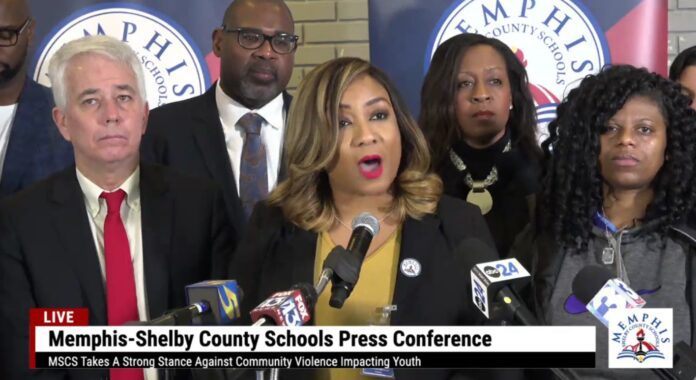Last month, Interim Memphis-Shelby County Schools Superintendent Toni Williams shared a very ominous statistic with the Memphis community.
Our school system, already this school year, has lost 22 students to violence. A number of other students, she said, are still “critically recovering” from violent attacks.

Last year was a very violent year here in Memphis, with a record 398 homicides, hundreds of robberies and smash-and-grab thefts, affecting children, families, and businesses throughout the entire community.
Memphis has long struggled with high rates of violent crime, especially among our youth. Teenagers and young adults commit a significant portion of the cities’ violent crimes. The child homicide rate in our city far exceeds national averages.
While national trends point to unintentional injuries as the top cause of death amongst American youth – in Memphis, violence is by far the most significant threat, especially homicide by firearm.
For example, the leading cause of death for children ages 7-18 in Memphis is homicide/assault. According to Memphis Crime Stoppers, in all of 2022, there were over 70 homicide victims aged 17 or under, including at least 15 children aged 12 or under.
A review of child deaths by Le Bonheur Children’s Hospital found that in 2020, homicide was the cause of more than 50 percent of all deaths amongst Memphis youth ages 15-24, and more than 75 percent of child deaths related to violence in Memphis involve a firearm. This reflects the city’s ongoing struggle with elevated rates of crime, gang activity, poverty, and other socioeconomic issues that endanger the lives of local children.
Community leaders have prioritized interventions to promote youth safety in hopes of mitigating these preventable deaths.
I think we all recognize that there is no single magic bullet for addressing youth violence. But to even have a chance at mounting a successful effort requires a multifaceted approach that prioritizes safety, equity, and deep collaboration among multiple entities.
I’m no expert, but any successes that we expect to achieve should start with addressing the root causes of violence in our communities, which is a very complex issue in and of itself. The causes of violence stem from a convergence of factors with deep historical and sociological roots.
Contributing factors to high youth crime include high rates of poverty, lack of economic opportunities, high school dropout rates, gang activity, easy access to firearms, and probably most importantly, a subculture that has normalized violence and retaliation.
Memphis already has multiple community-based programs that focus on public health, mentorship, interventions, and education, and they have shown some successes in reducing youth violence, but challenges clearly remain.
For example, it is reported that Memphis has a very high rate of disconnected or “opportunity” youth. Estimates suggest that around 24,000 youth aged 16-24 are neither enrolled in school nor participating in the labor force.
Many of our schools have adopted peer mediation programs and violence intervention/prevention curriculums to promote nonviolent conflict resolution among students.
The district partners with local law enforcement to provide better school security procedures. They have provided programs like “SAFE Zones,” which aim to provide safe spaces for students on their way to and from schools.
The school district provides an alternative school program for students with recurring behavioral issues aimed at intensive counseling and rehabilitation instead of suspension/expulsion. There are also “second chance” disciplinary policies to keep suspensions low.
Efforts are being made to provide students with more economic opportunities as well. There are mentoring, counseling, workforce partnerships, and vocational training programs to keep at-risk students engaged.
Schools are partnering with community groups, youth centers, health providers, and others to connect students and families to supportive services and violence prevention resources outside the classroom.
Memphis has expanded access to pre-K programs in recent years, reaching more children who may be susceptible to negative influences. Early childhood education can significantly impact long-term outcomes, including reducing the risk of involvement in crime.
Schools are increasingly incorporating Social and Emotional Learning (SEL) programs into their curriculum, teaching students essential skills like conflict resolution, emotional regulation, and decision-making. These skills can help young people avoid violence and make positive choices.
Lastly, several Memphis schools partner with community organizations to provide mentors for students who may be struggling or lack positive role models in their lives. Mentors can offer support, guidance, and encouragement, helping to reduce the risk of involvement in violence.
These are just some of the ways the education community in Memphis is working to address youth violence. Schools will continue to collaborate with law enforcement agencies, community organizations, and social service providers to develop comprehensive strategies for preventing violence.
But schools alone cannot eliminate the myriad of societal issues that lead to youth violence. Broader public health, public policy, and community support changes are still needed in tandem with the efforts put forth by our school system.
Building a safer community takes time, dedication, and collaboration from all sectors. We have to come together as one united community, put away our petty differences, and work toward a set of common goals and objectives.
We need to support our newly elected mayor, Paul Young, our new school superintendent (as soon as that person is hired), our interim Chief of Police, C.J Davis, and others who are trying to develop and implement solutions that will make our communities safe.
Just looking at the awful data regarding youth violence and hearing our school superintendent call for support in our community’s effort to “fight crime” is troubling; as if she doesn’t have enough to worry about.
Let’s work together, Memphis, and turn this situation around. It’s time!



